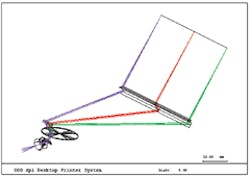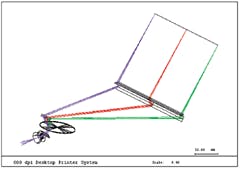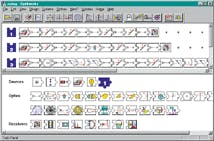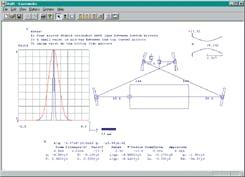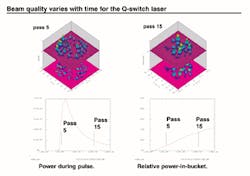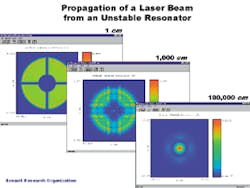Vendors discuss applications
Vendors discuss applications
for laser analysis and design
Laser designers tend to be less informed about design and analysis software than lens designers, so software tends to play less of a role in laser design than in lens design, according to James Kafka, advanced R&D manager for ultrafast laser systems at Spectra-Physics Lasers (SPL; Mountain View, CA). Laser designers may be paying a price in terms of lost efficiency, however, when they design systems without benefit of computer modeling.
As one step toward improving the information flow, Kafka gathered five software vendors into one room at the 1997 annual meeting of the Optical Society of America in October (Long Beach, CA) and gave each of them 15 minutes to describe what their software could offer laser designers.
"I was thinking of myself and of people like me who design laser systems and aren`t sure whether they`d like to use a lens-design tool to trace a Gaussian beam or whether they need to learn the more-sophisticated software for full diffraction analysis," Kafka said. "I think people don`t know which level of complexity is covered by which of the different software packages, so typically they don`t use any of them."
Kafka chose the five speakers based on his previous experience and that of his colleagues at SPL. The presentations spanned the full range of complexity in laser beam analysis and optical design. Tom Bruegge from Optical Research Associates (ORA; Pasadena, CA) and Dale Buralli from Sinclair Optics (Fairport, NY) discussed traditional lens-design tools that have become popular for relatively straightforward laser applications such as Gaussian beam propagation.
Henry Gintner of Optikwerk (Rochester, NY) discussed an icon-based optical design program and a CAD-based, nonsequential beam-tracing package for laser system design. George Lawrence from Applied Optics Research (AOR; Austin, TX) discussed sophisticated laser analysis and design software that uses a diffraction analysis model to fully specify complex beam-propagation problems. And Gary Peterson of Breault Research Organization (BRO; Tucson, AZ) discussed a systems-analysis software package that models complex laser configurations by combining multiple Gaussian beams.
Kafka also invited a representative of Optis (Toulon, France), who was unable to attend the meeting. Michael Gauvin at the Optis North American office (Tucson, AZ) did provide information for this article, however. Optis provides software modules that include both optical and laser design (see box on p. 212 for Web addresses of laser analysis and design software suppliers).
Code V and OSLO
Bruegge led off with a description of Code V, a traditional lens-design program from ORA that is widely used for laser applications. Code V provides both a Gaussian-beam-tracing capability for characterizing Gaussian propagation through complex optical systems and a geometric ray-tracing capability for skew ray paths, systems with nonconventional optical elements and nonorthogonal configurations.
The Gaussian-beam approach, he said, requires two conditions. The first is that the beam undergoes only negligible truncation, while passing through the optical system. The other is that the dominant aberration is astigmatism and that the beam footprint in the optical elements is much smaller than the radius of curvature of the elements.
Even with a simple, symmetric optical system, the beam characteristics cannot be described orthogonally by a pair of ABCD matrices if the beam follows a skew ray path, he said. In order to handle such a system the ABCD matrix approach must be generalized to a 4 ¥ 4 matrix. As an example, Bruegge displayed a Code-V model of a laser printer. The system used a diode laser source with astigmatism and a Gaussian intensity profile that differed in the orthogonal directions (see Fig. 1).
While the printer example did not contain a lot of elements, it did include several nontraditional elements, such as three holographic elements, a scan disk, a beam reflector, and a toroidal mirror, he said. In addition, even though the center of the beam was orthogonal, the beam paths at either edge were not. Computation of the generalized ABCD matrix for this system is best done by computer, he said, which allows characterization of the Gaussian beam distribution along the base ray path.
"It is possible to sit down with pencil and paper and try to figure out how the beam propagates through the system and to derive your matrix characteristics," he said. "But I can`t think of anybody who would consider this a productive use of their time."
Buralli of Sinclair Optics said that OSLO (Optics Software for Layout and Optimization) is similar to Code V in that it, also, is a traditional lens-design program that basically provides tools to help lens designers deal with the propagation of Gaussian beams through their optical systems.
The OSLO software, he said, has three levels. The first is a Gaussian beam spreadsheet for orthogonal and axially symmetric rays in which the ABCD spreadsheet works. The second deals with general astigmatism and propagation through a nonorthogonal system. An example would be two cylindrical lenses oriented at nonorthogonal angles (say 45°) to each other, which would require a 4 ¥ 4 beam trace. Limitations on this method of analysis are that it assumes that the beam is not truncated and that it only looks at effects up to second order (Fresnel diffraction) in the aperture. At the third level, the software recognizes effects of finite-sized apertures in the system or aberration effects higher than second-order astigmatism by using diffraction calculations for ray tracing.
Optikwerks and SOLSTIS
A discussion of Optikwerks was the third presentation of the evening. Gintner explained that this software differed from traditional lens-design software in a number of ways. For one thing, while Code V and OSLO can run on Windows-based PCs as well as engineering workstations, the two programs offered by Optikwerk (Optikwerks and Laserwerks) focus on a graphical Windows interface. Also, while most optical design and analysis software relies on spreadsheets for entry of system parameters, Optikwerks uses "drag-and-drop" icons for optical elements, such as lenses, prisms, mirrors, and apertures, to define a system (see Fig. 2).
The Laserwerks software is tailored for system design and simulation and has a CAD interface to provide nonsequential beam tracing. Gintner showed an example of a ring resonator modeled using Optikwerks and Laserwerks (see Fig. 3). The beam trace is interactively generated when the on-screen optical system is originally laid out or changed.
Optis, a French company that was invited to the meeting but was unable to attend, offers a series of Windows-based SOLSTIS modules that include both optical design and laser propagation, along with fiber coupling and photometry. As with most other software packages, the SOLSTIS system relies on spreadsheet entries, as opposed to the drop-and-drag approach in Optikwerks.
GLAD and ASAP
The most comprehensive among the laser design programs was presented by Lawrence of AOR, who described the GLAD (General Laser Analysis and Design) system. Originally developed for the laser fusion program in 1976, GLAD was applied to many cutting-edge, high-energy research programs in the 1970s and 1980s prior to becoming commercially available in the mid-1980s, Lawrence said. The goal of the program is to model every aspect of laser and physical optical solutions, he said. Instead of the Gaussian-beam analysis that is the staple of the other programs, GLAD focuses on full diffraction analyses.
"We use full diffraction calculations to perform end-to-end analysis of virtually any optical system from the simplest to most complex," Lawrence said. Examples presented by Lawrence included analysis of a Q-switched Nd:YAG laser (see Fig. 4), fiber-coupled lasers with multiple cores and measurement of the output of an excimer laser with Moiré fringes. Systems, properties, and functions handled by GLAD include resonators, aberrations, spatial filters, beam dividing, and nonlinear optics.
Software solutions tend to be tailored to applications, and a CD-ROM contains a fully functioning version of GLAD, more than 90 examples, and 1300 pages of documentation. The documentation provides the user with relevant examples that can provide a fast learning curve, despite the system`s complexity, Lawrence said. "We want accurate, detailed engineering answers, not textbook solutions," he said.
Somewhat less comprehensive but still able to handle many complex laser analysis problems is the ASAP (Advanced Systems Analysis Program) that Peterson described on behalf of BRO. ASAP was actually designed for a much wider array of analyses of geometries and sources than for laser applications, he said. Peterson added that ASAP is strictly an analysis (as opposed to design) tool.
Peterson described ASAP as a nonsequential beam propagation program that uses a Gaussian beam decomposition algorithm to model both Gaussian and non-Gaussian beams. Non-Gaussian beams are modeled through superposition of several Gaussians. The user can choose the number of Gaussians placed into the simulation depending upon the fineness of sampling desired. The program has the advantage of being able to model many complex beam situations without requiring the use of matrix propagation, differential equations, or Fourier transforms (in most cases), Peterson said.
Some limitations of this approach are that it cannot model guided waves or nonlinear optics. Examples presented at the meeting included a confocal unstable resonator (see Fig. 5), nonsequential propagation of a laser beam through a folded laser printer scanner, and polarization observed through a birefringent blister canopy. o
FIGURE 1. Optical system in laser printer schematic is symmetrical, but nontraditional features, such as holographic elements, scan disk, beam reflector, and toroidal mirror, do not allow for a simple orthogonal analysis.
FIGURE 2. Graphical Windows interface allows user to define an optical system by using the mouse to drag and drop icons for optical elements, such as lenses, prisms, mirrors, and apertures.
FIGURE 3. Nonsequential beam tracing generates beam data interactively with placement or adjustment of optical elements within system.
FIGURE 4. Diffraction analysis model of Q-switched Nd:YAG laser shows time variation in beam quality.
FIGURE 5. Gaussian beam
decomposition algorithm
shows laser beam profile
at selected propagation distances from a confocal unstable resonator.
